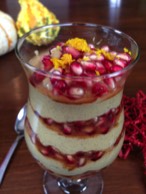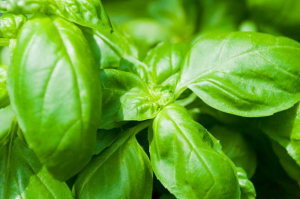
I love this recipe with just a tablespoon of fresh ginger juice added to the yogurt but I felt it may be too spicy for some so made the ingredient optional. This recipe of course has many benefits but for the gut I wanted to highlight the lemongrass with its microbe-modulating actions and its strong anti-fungal properties. The basil, too, can help to reduce unwanted small intestinal bacteria. If you are using a bifidum-only or a non D-lactate producing blend you may be able to tolerate yogurt parfaits, especially with the addition of basil and lemon balm even if you have symptoms of SIBO. In prevention, the ginger with its motility enhancing properties paired with the good bacteria in the yogurt (keeping bad bugs at bay) AND the antifungal/antimicrobial properties of lemongrass and basil you have powerful food here. Look below the recipe for some more specific benefits of each of these herbs.
Ingredients:
Coconut Yogurt 1 C
Lime,
1/2 Lemongrass,
1 stalk Basil, chopped fine,
3 T Pineapple Pieces, 1/3 C
1T Ginger juice (optional)
The recipe is served with pomegranate. See the full recipe HERE.
Each of these ingredients is beneficial across the body systems and each has a long history of use. Let’s get started!
Lime
Lime? Yes, lime. Really lime is not as fancy of an herb or may not be as much of a powerhouse as some of the other culinary herbs we talk about. But lime is so easy to incorporate into desserts, main dishes, drinks and more and its benefits, while subtle, cover some of the most important elements of our digestion, absorption and health. Lime can increase our stomach acid production when drank in water before a meal. Better stomach acid means better breakdown of minerals and proteins, leading to better nutrition! Increased stomach acid can also lead to better bile production which helps our bodies rid themselves of fat soluble toxins, can help with digestive motility, reduce opportunistic bacteria in the small intestine, decrease fungi and more. Better bile production means better digestion of fats. Lime is rich in antioxidants including many flavanoids and also vitamin C. This can help with free radicals anywhere in the body, for example in the skin. Lime and lemon can also be used for a gentle liver support by drinking citrus in water in the morning before taking any food. Be cautious if you have a history of digestive pain if you are starting this in large amounts however.

Lemongrass
Lemongrass has anti-fungal and antibacterial properties like many of the herbs mentioned here (I prefer to say microbe-modulating), but is particularly strong in the antifungal department. This makes lemongrass a great seasoning or herb to consider using whenever working to balance yeasts in the body. Lemongrass has also been found to lower cholesterol and also decrease the spread of cancer. Just as I like to reframe how lemongrass works with fungi in the body I like to view “anti-cancer” as lemongrass altering the conditions within us that encourage the growth of cancers. Doesn’t mean it’s curing anything or that it’s anything near a holistic remedy. It’s just one food. Lemongrass has been shown to reduce inflammation and pain. I love lemongrass in green juice, in desserts and in thai curry kale chips. Yum. I know you want some!

Basil
Basil is a carminative herb which means it can reduce spasming of muscles in the digestive system, thereby relieving gas/bloating/pain and more. Surprisingly many people experience digestive pain because the smooth muscles surrounding the digestive system are tight in one place, uncoordinated or just in spasm. Basil, along with other herbs like cardamom and peppermint can relieve this problem as a mild relaxant (AKA carminative). Basil seeds have been found to have blood sugar lowering effects. Basil has been found to have anti-inflammatory properties and can also lower the acid-producing bacteria that upset the digestive balance. Basil and the diluted oil of basil have been found to reduce P. acnes, the bacteria that contribute to acne. There are many studies about the antibacterial properties of basil essential oil and there is a time and place for that however it is great to incorporate the whole plant as much as possible into foods. Who doesn’t love a good pesto? Or a basil ice cream – don’t knock it until you try it! Don’t confuse basil with holy basil, they are different plants though related. I enjoy adding basil to green juices with celery, lime and cucumber. There are many savoury and sweet ways to enjoy this powerful herb. Ice cream tho….

Coconut
Wow. Coconut. This is a powerhouse seed full of amazing properties that are just too much to mention in this article. The oil of coconut can provide short term energy, is easier to digest than many fats (um tastes awesome) and has proven benefits to the brain. In numerous studies the medium chain triglycerides have been found to improve cognitive performance of people diagnosed with Alzheimer’s disease, notably one published in Neurobiological Aging in March of 2004. But there have been dozens of similar studies. Caprylic acid and Undecalynic acid, both found in the oil of coconut have anti-fungal properties and in fact are arguably the two strongest anti-fungal substances in the western canon. Coconut has been found to lower LDL cholesterol, raise cholesterol in people who have it too low, decrease blood pressure and help with skin conditions.
Again, wow. Coconut oil can also help to increase our conversion of ALA fats up to 10 times – like converting flax oil to EPA and DHA which we need for brain, skin, inflammation reduction and metabolic health (and more). One word of caution about Coconut oil though… it’s not the best oil for the face as it can clog pores. If the nutrient rich coconut water is too sweet for you try fermenting it into a Coconut kefir (just do a google search). The coconut water will not have those fatty acids but will have healthy minerals. If you love coconut water try it with a splash of lime and some ginger, it’s amazing!

Pineapple
You probably know pineapple contains bromelain which can be a helpful digestive enzyme and also can be good for the skin in some people. But did you know that it was almost 30 years ago that Bromelain, both heat treated and raw, was found to reduce the spread of lung cancer? Bromelain was found to actually increase the survival rate of all sorts of cancers in animals (except melanoma). It has been found to benefit sinus congestion, inflammation, swelling in different parts of the body, inflammatory bowel conditions and more. Bromelain may benefit the liver. It is also a strong exfoliant and can be irritating for some people so is either amazing or a bit too much when applied topically to the face and hands. I love the dichotomy of this fruit being so sweet, too sweet for many people, and also at the same time reducing inflammation. Also with Bromelain’s anti-fungal properties this is a very interesting fruit. If you find pineapple too sweet on its own for your blood sugar tolerance try alternating it with bites of something fibrous and mineral dense like kale or romaine. We have really bred our fruits to be crazy sweet. Whether you find a way to enjoy pineapple in its whole, natural form or you prefer to use the proteolytic enzyme Bromelain I hope you continue to love this ingredient as I do.

Ginger
When I lived in China one of my friends commented that I was always drinking ginger tea and that I was using Chinese medicine. I said “no. I just like ginger.” They argued with me for several minutes, explaining that whether I intended to utilize the medicinal benefits of ginger or not I was still benefiting from all of the biochemical actions of the plant and from the long history of its use in Chinese medicine. Looking back on this conversation I laugh because indeed it would be impossible to escape the many benefits of ginger.
Has been shown to help with menstrual pain
Has been shown to reduce pain and have anti-inflammatory properties in hundreds of studies. By increasing Serotonin in the digestive system, ginger is able to help with small intestinal motility. For some folks with SIBO 1000 mg of ginger or more can significantly increase small intestinal migrating motor complex and decrease their bloating and symptoms.
Ginger has been used worldwide as a remedy for nausea for literally thousands of years. Ginger is a carminative herb which means it can relax spastic muscles in the digestive system, often relieving gas and bloating. Ginger was found in a study published in the Saudi Medical Journal, 2008, to lower LDL cholesterol. Ginger was found to lower fasting glucose, C reactive protein, triglycerides, hemoglobin A1C, insulin and more type-2 diabetes markers significantly in the International Journal of Food Science in 2014
Anyway I highly recommend you make THIS recipe and add ginger to it. Or maybe add it to everything?
🙂
Read more
















